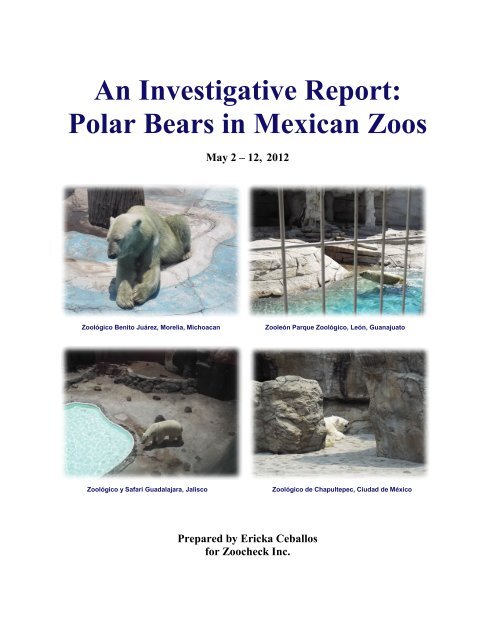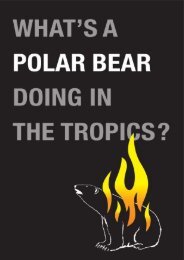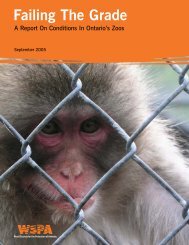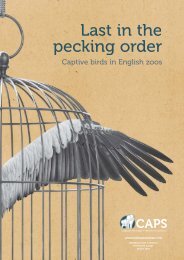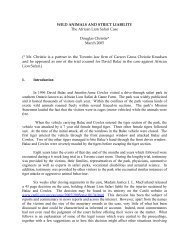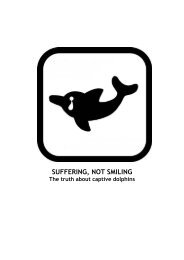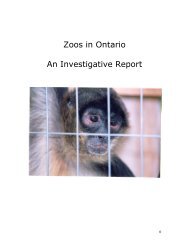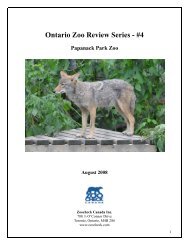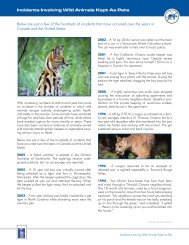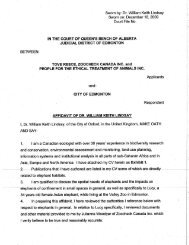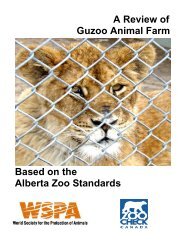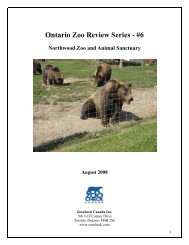An Investigative Report - Polar Bears in Mexican Zoos
An Investigative Report - Polar Bears in Mexican Zoos
An Investigative Report - Polar Bears in Mexican Zoos
Create successful ePaper yourself
Turn your PDF publications into a flip-book with our unique Google optimized e-Paper software.
Z oocheck Inc.788½ O’Connor DriveT oronto, OntarioC anada, M4B 2S6zoocheck@zoocheck.comw ww.zoocheck.comPage2
I ntroductionThisreport isa follow up to previous exam<strong>in</strong>ationso f Yupi, a f emale polar bear resid<strong>in</strong>g att he M orelia Zoo (Zoologico D e Morelia, Benito Juarez) <strong>in</strong> Morelia, Mexico. This review alsoi ncludes <strong>in</strong>formationabout other polar bears <strong>in</strong> Mexico, gleaned from visits to the variousf acilities that house these iconic animals.A ll of the polar bears observed dur<strong>in</strong>g this review were housed <strong>in</strong> antiquated, barren,a rtificial concrete/gunite exhibits. All appeared to suffer from the heat, a problemexacerbated by the lack of shaded rest areas and/or other areas <strong>in</strong> which the bears couldobta<strong>in</strong> relief f rom the heat (the sole exception wasthe Leon exhibit which had a substantials haded area). None of enclosures providedsoft substrate areas as comfortable rest stations,forthermoregulation or as behavioural enrichment.The Morelia Zoo was thee xception,h av<strong>in</strong>g just provided a s and pit a rea forYupi,their resident polar bear.Most of the bearsobservedseemedto be distressedt o some degreeor were show<strong>in</strong>g behavioural <strong>in</strong>dicators ofproblems,such as stereotypies and/ orlethargy.The welfare status of off-exhibit bears, sucha s the m ale polar bear at the Chapultepec zoo k ept, was not determ<strong>in</strong>ed.I t is clear that the conditions experienced by polar bears <strong>in</strong> <strong>Mexican</strong> zoos are poor and thatt h<strong>in</strong>gs have to change. Zoocheck recommends that the follow<strong>in</strong>g four steps be taken:1 . The physical health of each bear should be assessed by qualified <strong>in</strong>dependentv eter<strong>in</strong>ary experts, work<strong>in</strong>g with exist<strong>in</strong>g zoo veter<strong>in</strong>ary and care staff, and anappropriate care program delivered. <strong>Bears</strong> requir<strong>in</strong>g pa<strong>in</strong> management should be apriority and if the pa<strong>in</strong> cannot be mitigated, then humane euthanasia should bec onsidered.2 . H eat relief strategies should be employed as quickly as possible to reduce heat stressand to <strong>in</strong>crease each bear’s comfort level. Measures could <strong>in</strong>clude, but are notlimited to, overhead shade cloth, cool natural substrate areas, allow<strong>in</strong>g access ton ight quarters, air condition<strong>in</strong>g,fans for air circulation, water misters, refrigeratedp ools, etc.3 . Each zoo should <strong>in</strong>stigate an <strong>in</strong>dependent expert husbandry assessment thate xam<strong>in</strong>es all aspects of p olar bear management, c are a nd welfare that would servea s a basis for additional improvements(such as a program of environmentalenrichment)to mitigate some of the issues fac<strong>in</strong>g the animals. The results of thosea ssessments and t he recommendations that stem from them should be followed.4 . Each zoo shouldseriously evaluate the feasibilityof relocat<strong>in</strong>g their polar bear(s) tomoreappropriate accommodation elsewhere. T his is recommended because thezoosdonot have sufficientspaceo r f<strong>in</strong>ancesto provide suitable accommodation for polarb ears and there is little that can be done to fully mitigatethe detrimental effectsthatw arm climates have on the animals.Page3
M orelia Zoo,MichoacanY upi was an orphanedcub from Alaska. <strong>Report</strong>edlyhe r motherw askilledb y a hunterands he ended up <strong>in</strong> an Alaskan zoo. Numerousfacilities wanted Yupi,buttheMoreliaZ oo waschosent o receive her. S he is nowm ore than 20yearsold ( t here is some debateregard<strong>in</strong>gh er actual age)and <strong>in</strong> J une it will be a pproximately t wenty years s<strong>in</strong>ces he arriveda t theM orelia Zoo.Observations:I first observed Yupi <strong>in</strong> 2009, when Zoocheckasked me to visit the zoo todeterm<strong>in</strong>ewhether Yupi’s environment and liv<strong>in</strong>g conditions had improved <strong>in</strong> the 3 . 5 yearss<strong>in</strong>ceZoocheck’s first visit i n 2005.Yupi’sfur was a much darker green colour this time, f ar from the light greenc olorobservedi n 2009.Yupialso appeared to have l ost weightand her belly flesh was “hang<strong>in</strong>g”. The zoo’sv eter<strong>in</strong>arian said Yupil ost weightbecause she just f<strong>in</strong>ished her heat season and dur<strong>in</strong>gt his time she refused to eat.A small s andp ithadbeen <strong>in</strong> stalled a few days previously. Apparently, the s and w as mixedwith clay to keep it humid and at a cool temperature. Accord<strong>in</strong>g to the zoo director, Yupiw as a bit anxious and unsure about it at the beg<strong>in</strong>n<strong>in</strong>g, so she approachedit with caution.Theday after i t was <strong>in</strong>stalled Yupit ouchedthesand and<strong>in</strong>subsequent days started to digi n it.S ome triangulara wn<strong>in</strong>gsmadeof textile, had been erectedoverthes andpita reato provides hade. U nfortunately, the awn<strong>in</strong>gs cover only a small portion of the enclosure.Zoo staffPage4
ema<strong>in</strong>sunclear. C urrently,streams of water are spout<strong>in</strong>g from various locations <strong>in</strong>to thep ool. <strong>Zoos</strong>taff stated that they<strong>in</strong>tend to build a real waterfalltoprovideadditionalcooli ng.Thesandpitand new awn<strong>in</strong>gs. N ote the watert he pool at several locations.spout<strong>in</strong>g <strong>in</strong>toYupidigg<strong>in</strong>g<strong>in</strong> thesandp it.Page6
Yupi<strong>in</strong> heat ofMorelia( 32 degrees C / 70% humidity)Y upipull<strong>in</strong>g barrel out of the pool.Page7
Y upi l ies on concrete substrate at the hottest po<strong>in</strong>t of the day.Information kiosk aboutYupi andp o lar bearsc reated by the former zoo director.Page8
A banner stat<strong>in</strong>g that Yupi has lived a ll her life at the Morelia zoo“ t erritory,” t hat she feels safe and that Morelia is proud to have her.whereshehasherNight quartersY upi<strong>in</strong> night quarters.I was show n thei nterior night quarters, whichrema<strong>in</strong>ed unchanged from previous visits.T he zoodirector<strong>in</strong>dicated theyhave plans to<strong>in</strong>stallplexiglassw <strong>in</strong>dows or skylights<strong>in</strong> theceil<strong>in</strong>gt o allow natural light <strong>in</strong>to this area. However,at the present time, it rema<strong>in</strong>s dim,Page9
arren and lacksf urnish<strong>in</strong>gs or materials to make it more comfortable. T here weresomec hicken p arts and bread carefully s orted out on the floor.A bout Morelia: M orelia is the capitol of the state of Michoacan de Ocampo. Morelia has anarea of 78 km ² and a population of 597,511 <strong>in</strong>habitants accord<strong>in</strong>g to the results of the ThirteenthCensus of Population and Hous<strong>in</strong>g Census 2010. Morelia is located at 1951 meters above the seal evel and h as a template climate with medium humidity.Page10
L eon,Guanajuato ZooS hiber isa lonefemale polarbear, age and orig<strong>in</strong> not determ<strong>in</strong>ed. I n previous years, a maleb ear w as housed with her, but he p assed away many years ago.O bservations: At10:03am,Shiber was already display<strong>in</strong>ga stereotypic behaviour,pac<strong>in</strong>gb ack and forth <strong>in</strong> the shallow water. She walked 12 steps to the right, turned around andw alked 12 stepsback to the left, before turn<strong>in</strong>g ar ound and repeat<strong>in</strong>g the pattern.Dur<strong>in</strong>gtheobservation period, she took threes mall breaks of 10- 20 secondseach, with the pac<strong>in</strong>gbehaviourterm<strong>in</strong>at<strong>in</strong>g a t 12:01 pm.A t 12:02 Shiber exited the water and moved to the door of her <strong>in</strong>terior quarters. She movedtwos teps toward the gate,r ema<strong>in</strong>ed there for2 - 10 seconds, then backed off and walkedt oward herpool, t ak<strong>in</strong>g10s teps(7 <strong>in</strong> the shaded area, 3 <strong>in</strong> the unshaded area) beforeturn<strong>in</strong>gand repeat<strong>in</strong>gt he patterna ll overa ga<strong>in</strong>.At12:43 pm., she was allowed i nside,atwhich po<strong>in</strong>t a staff member entered her enclosureto wash t he floorw ith a hose.At 1:05 pm.she was back out, returned to the shallow water and resumed stereotyp<strong>in</strong>g. My observationp eriod was term<strong>in</strong>ated at 1.47 pm. She was still pac<strong>in</strong>g.Page11
I returned the next day for several hoursb ehaviours as t he day before.and she wasr epeat<strong>in</strong>gthe same abnormalShiberexpress<strong>in</strong>gabnormalbehaviours1 ) Int he water2 ) W alk<strong>in</strong>g back and forth to night quarter entrance.Page12
E xhibitTheexhibitarea consists of a concrete/ gunite floor area and walls, molded to resemble“ natural” rock a nd pa<strong>in</strong>ted <strong>in</strong> white.Thearea is approximately30ml ong.<strong>An</strong> overhang att he back of the exhibit provided a shaded area, and conta<strong>in</strong>ed the access gate(s) tonightq uarters (kept shut).Metalbarsat visitor view<strong>in</strong>g stationsallowp eople to throw rubbish<strong>in</strong>tothep ool.Iobservedcandy wrap pers and other paper debris float<strong>in</strong>g on the water surface.Page13
E xhibit v iewed from the visitors tation.S hiber a t the gate to her night quarters.A bout Leon: A ltitude1800ma boves ea level. The 2010 census reported that the City ofL eon had 1,720,733 residents. Leon has a subtropical climate with summer ra<strong>in</strong>fall. Thetemperature<strong>in</strong> Leon reached 34 degrees C dur<strong>in</strong>gthe first day of my visita nd 37 degrees Co n the second day.Page14
G uadalajara,JaliscoAgataisoneof two polarbears at the GuadalajaraZoo <strong>in</strong> Jalisco.She came to the zooapproximately14- 15years ago. I was <strong>in</strong>formed that another older malep olar bear(nameunknown)hasbeen at the zoof or even longer. <strong>Report</strong>edly a f emale b ear was brought <strong>in</strong> toma te with him, but the malekilled the female. Not too long afterward,they brought asecondy oung female( Agata), but apparently the male attacked hert oo.The zoo has keptthemseparated s <strong>in</strong>ce that time.Thestaff <strong>in</strong>formedm e that the male is about 30 years old and thath e isn’t allowed <strong>in</strong>tothee xhibition area v ery o ften.However, I was given two somewhat contradictory accounts ofhissituation. On the one hand I was told that themale stayspermanently <strong>in</strong> the off-exhibitarea,becausehe only wants to sleep and he ism ostly<strong>in</strong>active, while another personi nformed me that the bears are rotated on a day <strong>in</strong>/ day out basis. On the twod aysof myv isit, only the female was on display. S he was relatively a ctive.Obser vations: When I arrived,I observed Agatasleep<strong>in</strong>gforapproximately1 hour.Theu nderwater view<strong>in</strong>g w<strong>in</strong>dows were quite dirty which m ade it difficult to view her, but Ic ould see that she was sleep<strong>in</strong>g <strong>in</strong> an unshaded area with the temperature register<strong>in</strong>g37degreesC. A little later she got up, so to get a better observation po<strong>in</strong>t I moved to thee levated view<strong>in</strong>g station, but the w <strong>in</strong>dowst here were also dirty mak<strong>in</strong>g view<strong>in</strong>g difficult .Page15
Agatae nteredherpooland was play<strong>in</strong>g with a b lueplastic barrel, dragg<strong>in</strong>g it out of thewaterand then throw<strong>in</strong>g it <strong>in</strong> aga<strong>in</strong>. I saw her dive<strong>in</strong>to the pool several times. Nostereotypicb ehaviourswere observed, but dur<strong>in</strong>g thehottest hours(39 degrees C),shea ppeared anxious to enter her night quarters, walk<strong>in</strong>g t o t he accessgate several times.E xhibitT heview through the glass.Page16
Agata’sna rrow pool appeared to be approximately 10m long and about 2md eep.Herexhibitionarea issomewhat horseshoe-shaped and consists of concrete/gunite substratea nd walls. There are some small shaded a reas, but nowhere for her to retreat from publicv iew. The entire area is about 30m long by 15m w ide.AsI was gett<strong>in</strong>g readyt o leave, I noticed Agataplay<strong>in</strong>gwith a plastic Cokebot tle.S<strong>in</strong>ce It hought it may be a hazard if shewere tochewi t apartand s wallow a piece,I located zoostaffand asked them to remove it. It took 45 m<strong>in</strong>utes (and 5 compla<strong>in</strong>ts) before they lockedAgata<strong>in</strong>to h er night quarters and t hen removed what was was left of the plastic bottle.Accord<strong>in</strong>g to zoo e mployees, thed elayw as due to keeper staff be<strong>in</strong>g on their lunch break.Agatawithp lastic bottle.A bout Guadalajara: G uadalajara hasa population of 1,564,514,mak<strong>in</strong>g it Mexico'ssecond most pop ulous municipality, witha h umid subtropical climatefeatur<strong>in</strong>g dry, mildw<strong>in</strong>ters and warm, wet summers. Guadalajara's climate is <strong>in</strong>fluenced by its high altitude1,566 m (5,138 ft. ) and the temperature is warm all year-r ound. The heat and heavyp ollution of the metropolitan area make it difficult to breath at timesPage17
a ppeared to be <strong>in</strong> pa<strong>in</strong>. Several visitors were heard comment<strong>in</strong>g on her sad condition ands everal said she looked like she was go<strong>in</strong>g to die.T he bear, prodded by a keeper,struggledt owalk t oward the visitor v iew<strong>in</strong>g area.Page21
T hebear moved very slowly.A fter the view<strong>in</strong>g w<strong>in</strong>dow, the keeper took the bearb ack and allowed her <strong>in</strong>to her night quarters.Page22
A bout Mexico City: M exico City is the Capital of the <strong>Mexican</strong> Republic and has ane stimated 8.8 million <strong>in</strong>habitants. It is located at2 ,240m abovesea level and the climate ist emperate to humid cold.Page23
R ecord of polar bears <strong>in</strong> MexicoAccord<strong>in</strong>gto SEMARNAT( The M<strong>in</strong>istry of Environmentand Natural Resources)i nf ormation, t here are (or were) 8 polar bears <strong>in</strong> Mexico.It seems that there are not anyproperdocuments that prove the “legal orig<strong>in</strong>” of 7 of theseb ears because they enteredM exico prior to t he <strong>Mexican</strong>G eneral Wildlife Law be<strong>in</strong>g implemented <strong>in</strong>2000.R e gistros,autorizaciones, permisos, marcas y certificados de legal procedencia y/on acimiento de ejemplares de Ursus maritimus ( Oso polar)NUMERODEM ARCAJEM icrochip000635072FG rapaZ ool Chap001Microchip020*623*587Microchip021*292*344Microchip00001473ª0S EXO O RIGENDOCUMENTO QUEA CREDITANOMBRE DELZOOLÓGICOQUE LOA LBERGAParque ZoológicB enito JuarezH embra I mportaciónD esconocidooM acho I mportaciónD esconocidoDirecciónGeneral deZoológicos yVida Silvestre( Chapultepec)H embra I mportaciónD esconocidoDirecciónGeneral deZoológicos yV ida Silvestre( Chapultepec)H embra I mportaciónD esconocidoDirecciónGeneral deZoológicos yV ida Silvestre( Chapultepec)H embra I mportaciónD esconocidoParque Zoológicod e LeonN o disponible m achoD esconocidoD esconocidoParque Zoológicod e LeonN o disponible M achoImport aciónCERTIFICADO DEORIGEN defecha29/02/99(pedimentoaduanalZoológico deG uadalajaraNÚMERODER EGISTRODFYFS/ZOO-E-0026-99-M ICH.DGVS-ZOO-E-0007-98-D . F.DGVS-ZOO-E-0007-98-D . F.DGVS-ZOO-E-0007-98-D . F.INE/CITES/DGVS-ZOO-E-0014-97-G TO.INE/CITES/DGVS-ZOO-E-0014-97-G TO.DFYFS-ZOO-E-0030-99/JALPage24
Page5268471disponibleoN aembrH nmportacióI oesconocidD edZoológicouadalajaraGFYFSD -OOZ-E-0300 - L9/JA93aretherelistthistoccord<strong>in</strong>gA p oZoChapultepec<strong>in</strong> thebearslaroofTwoCity.<strong>in</strong> Mexicomicrochippedhem aret.unknown.isbearstheoftwoofstatuscurrenttheowever,H<strong>in</strong>formationheTtheAllMexico.<strong>in</strong>bearspolarfemale5aretherethathowssbearsolarpIsofemale,werebservedofrombearfemaleathatpossibleIt’sfor.unaccountedisbearoneGuadalajaratosentonethewasZoohapultepecCthenwasandpurposesbreed<strong>in</strong>gforbear.maleresidentthebyilledkaGuadalajarofmalethenlyOnOrigiofCertifcateaashnd tanamaleehLeonoffemaleddahITES permits.Caretherethat<strong>in</strong>dicateslistheT3bears:polaralem .CityLeon and Mexicouadalajara,G eWnow thatktthaandawaypassedLeon<strong>in</strong>malehetemalnothera dah diedoagyearsanymZooMoreliatafoecausebagarbonsum<strong>in</strong>gceg. eonishereTrbeapolaralemaGuadalajarnimalesecondaapparentelyndaMniixe .Cityoc 1201anI erticlarHorroofZooThentitledettp://www.scribd.com/doc/56620056/RevistaHabitath -3 fomadeisentionmehtpolarmaleatearbahCoZoultepecp .13,n pageO rpolaun osocontienen abarroteslosun calabozoespero“ epuednoque<strong>in</strong>mensounTienestirar.e lepisa<strong>in</strong>st<strong>in</strong>tosuEncam<strong>in</strong>ata.unasimulaotroelconamputado,brazovesrticoáElreja.contratopesdedaseytarimaunagolpearasca,vehementeperotigial,diámetro.decentímetros30deúlceraunaporlaceradoestáodoc onquetratamiento,suEnAshígado.elhan petrificadolequeanestésicos,dedosis180recibidohauración,cqueríaloíestán exhibición alNodirectora.a exl neyacen enfermosqueanimalesmuchoscomopúblico,Chapultepec”dezoológicodelergástulasaslranslation:TandcagesmallanIcan’tthatbearpolarhugeaistherebarseh<strong>in</strong>dbevenThisout.tretchs30ulceranbylaceratediselbowTheleg.amputatedanhasbearpolarwideentimeterscndaareceivedashecurdoesn’tthatreatmenttofimhofdoses180whichnalgesics,aotherandbearThisbear.theofliverthepetrifiedavehsnimalanotaretxhibite .publictheoalsoarticleheTentionsmnbehihatteeypublicthediscellarssmallnianwithdeerathewithwallabies,bl<strong>in</strong>d5escape,totry<strong>in</strong>gdoorthetobodyitsslamm<strong>in</strong>glegamputateddraggedarethatorbitstheofoutyeseutohtwhereareaanottheunderbitatwistcaneyun,sotherndaoforrorshthewhichforcrueltynimalaormerfneverwasdirectoranctioned.sethesllAerayeportedlroctheofwillhetZChapultepecformertroversialnooirectdoBastien whElena HoyoMariaroieuthanasad a nohrule.anotherA sstatearticle0112 cChapultepethehattZ oo s’theofmanythatproblem ismajor(oldtooaretherenimalsameghasiz<strong>in</strong>phetemalefapandthebear,olarp s sgorilla,andrango - )tansu: 3ttp://www.razon.com.mx/spip.php?article7987h
C onclusionsA ll of the polar bears observed dur<strong>in</strong>g this review were housed <strong>in</strong> antiquated, barren,artificial concrete/gunite exhibits. All appeared to suffer from the heat, a problemexacerbatedby thelack of shaded rest areas and/or other areas <strong>in</strong> whichthe bears couldo bta<strong>in</strong> relief (the sole exception was the Leon exhibit which had a substantial shaded area).None of enclosures provided soft substrate areas as comfortable rest stations, forthermoregulation or as behavioural enrichment. The Morelia Zoo was the exception, hav<strong>in</strong>gj ust provided a modest s and pit areaforYupi,their resident polar bear.Most of the bearsseemedto be experienc<strong>in</strong>gsome level of distresso r were show<strong>in</strong>g behavioural <strong>in</strong>dicatorsofproblems,such as stereotypies and/ orlethargy.The welfare status of the off-exhibit bears,such as the malepolar bear at the Chapultepecz oo, was not determ<strong>in</strong>ed.I t is clear that the conditions experienced by polar bears <strong>in</strong> <strong>Mexican</strong> zoos are poorand thatt h<strong>in</strong>gs have to change. Zoocheck recommends that the follow<strong>in</strong>g four steps be taken:1 . The physical health of each bear should be assessed by qualified <strong>in</strong>dependentv eter<strong>in</strong>ary experts, work<strong>in</strong>g with exist<strong>in</strong>g zoo veter<strong>in</strong>ary and care staff, and ana ppropriatecare program delivered. <strong>Bears</strong> requir<strong>in</strong>g pa<strong>in</strong> management should be apriority and if the pa<strong>in</strong> cannot be mitigated, then humane euthanasia should bec onsidered.2 . H eat relief strategies should be employed as quickly as possible to reduce heat stressand to <strong>in</strong>crease each bear’s comfort level. Measures could <strong>in</strong>clude, but are notlimited to, overhead shade cloth, cool natural substrate areas, allow<strong>in</strong>g access tonight quarters, air condition<strong>in</strong>g, fans for air circulation, water misters, refrigeratedp ools, etc.3 . Each zoo should <strong>in</strong>stigate an <strong>in</strong>dependent expert husbandry assessment thatexam<strong>in</strong>es all aspects of polar bear management, care and welfare that would serveas a basis for additional improvements (such as a program of environmentale nrichment) to mitigatesome of the issues fac<strong>in</strong>g the animals. The results of thosea ssessments and the recommendations that stem from them should be followed.4 . Each zoo should seriously evaluate the feasibility of relocat<strong>in</strong>g their polar bear(s) tom ore appropriate accommodation elsewhere. This is recommended because the zoosdo not have sufficient space or f<strong>in</strong>ances to provide suitable accommodation for polarbears and there is little that can be done to fully mitigate the detrimental effectst hat warm climates have on polar bears.Page26


